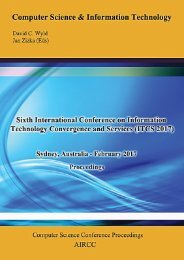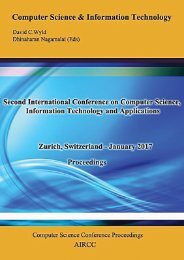CoSIT 2017
Fourth International Conference on Computer Science and Information Technology ( CoSIT 2017 ), Geneva, Switzerland - March 2017
Fourth International Conference on Computer Science and Information Technology ( CoSIT 2017 ), Geneva, Switzerland - March 2017
You also want an ePaper? Increase the reach of your titles
YUMPU automatically turns print PDFs into web optimized ePapers that Google loves.
42 Computer Science & Information Technology (CS & IT)<br />
The eigenmodes of the stroke-centre covariance matrix are used to construct the point-distribution<br />
model. First, the eigenvalues e of the stroke covariance matrix are found by solving the<br />
eigenvalue equation | Σ ω − e ω I |= 0 where I is the 2 L × 2L<br />
identity matrix. The eigen-vector<br />
φ<br />
i<br />
corresponding to the eigenvalue<br />
Σ φ =<br />
ω ω ω<br />
i<br />
e i i<br />
ω<br />
e<br />
i<br />
is found by solving the eigenvector equation<br />
φ . According to Cootes and Taylor [6], the landmark points are allowed to undergo<br />
displacements relative to the mean-shape in directions defined by the eigenvectors of the<br />
covariance matrix Σ . To compute the set of possible displacement directions, the M most<br />
ω<br />
significant eigenvectors are ordered according to the magnitudes of their corresponding<br />
ω ω ω<br />
eigenvalues to form the matrix of column-vectors Φ ( φ | φ | ... | φ ) , where<br />
ω =<br />
1 2<br />
M<br />
ω ω ω<br />
e<br />
1<br />
, e2<br />
,....., e M<br />
is the order of the magnitudes of the eigenvectors. The landmark points are allowed to move in a<br />
direction which is a linear combination of the eigenvectors. The updated landmark positions are<br />
given by X ˆ = Y + Φ γ , where γ<br />
ω<br />
is a vector of modal co-efficients. This vector represents<br />
ω<br />
ω<br />
the free-parameters of the global shape-model.<br />
ω<br />
This procedure may be repeated to construct a point distribution model for each stroke class. The<br />
t<br />
set of long vectors for strokes of class λ is T = {<br />
,<br />
| λ = λ}<br />
. The mean and covariance<br />
λ<br />
Z t k<br />
matrix for this set of long-vectors are denoted by Y<br />
λ<br />
and<br />
Φ<br />
λ<br />
. The point distribution model for the stroke landmark points is<br />
k<br />
Σ<br />
λ<br />
and the associated modal matrix is<br />
Z ˆ = Y + Φ γ .<br />
We have recently described how a mixture of point-distribution models may be fitted to samples<br />
of shapes. The method is based on the EM algorithm and can be used to learn point distribution<br />
models for both the stroke and shape classes in an unsupervised manner. We have used this<br />
method to learn the mean shapes and the modal matrices for the strokes. More details of the<br />
method are found in [7].<br />
3. HIERARCHICAL ARCHITECTURE<br />
With the stroke and shape point distribution models to hand, our recognition method proceeds in<br />
a hierarchical manner. To commence, we make maximum likelihood estimates of the best-fit<br />
k<br />
parameters of each stroke-model to each set of stroke-points. The best-fit parameters γ λ<br />
of the<br />
stroke-model with class-label λ to the set of points constituting the stroke indexed k is<br />
k<br />
γ<br />
λ<br />
= arg max p ( zk<br />
| Φλ,<br />
γ )<br />
(5)<br />
γ<br />
We use the best-fit parameters to assign a label to each stroke. The label is that which has<br />
maximum a posteriori probability given the stroke parameters. The label assigned to the stroke<br />
indexed k is<br />
λ<br />
λ<br />
λ





